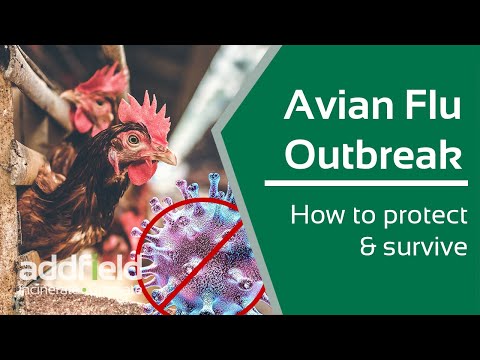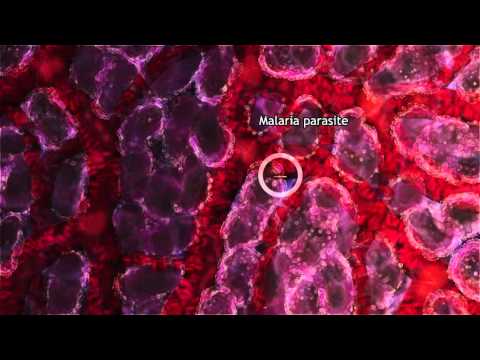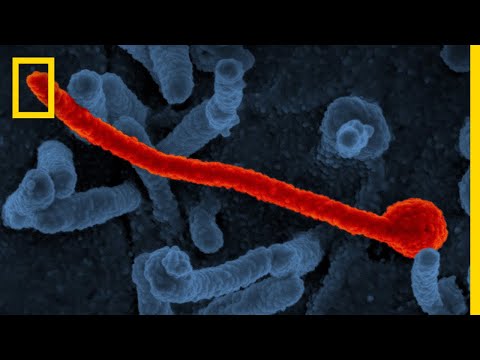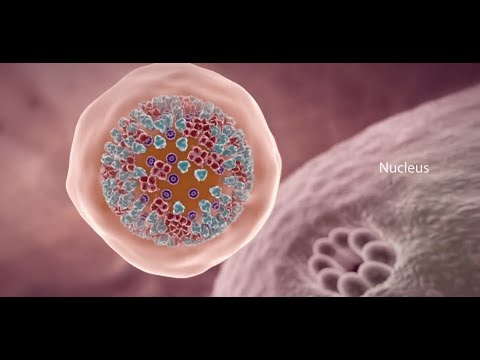10 Toxoplasmosis
Toxoplasmosis is a parasitic infection caused by a microorganism called Toxoplasma gondii, or T. gondii. This parasite exists everywhere—in air, on land, in the sea, and in most warm-blooded animals. However, its primary hosts are house cats. The microorganism sexually reproduces inside the cat’s guts—not a very romantic honeymoon spot. It is sometimes also known as the “mind control” disease since rodents infected with the parasite show abnormal behaviors and become easier prey to cats. T. gondii can also increase risky behaviors in humans. Watch this video on YouTube People can contract Toxoplasmosis through contact with infected cat feces or by consuming contaminated raw vegetables or undercooked meat. T. gondii usually enters our bodies in the form of an egg and hides in the brain, heart, or skeletal muscle tissue. When it grows, it becomes an active parasite known as a tachyzoite. A tachyzoite can quickly multiply and spread to attack body tissues with limited immune defenses. Toxoplasmosis affects up to 2 billion people globally. Most people will have no noticeable symptoms and don’t require treatment for Toxoplasmosis. Up to 20% will have mild symptoms such as swollen lymph nodes or flu-like aches. In rare cases, severe infections can lead to: If brain damage continues without treatment, especially in people with weak immune systems, Toxoplasmosis can be fatal.
9 Salmonellosis
Salmonellosis is a bacterial infection caused by the bacteria Salmonella. You can find the Salmonella bacteria in domestic and wild animals, including pigs, cattle, cats, dogs, poultry, birds, reptiles, and amphibians. Infected animals often don’t show signs of the disease, so make sure to wash after handling them. For example, if you have a pet turtle, it can have Salmonella on its body and anywhere in its tank. Watch this video on YouTube Salmonella on your hands can lead to infection or spread to other people and surfaces. Salmonella is also pretty resilient and can exist throughout the entire food chain. Humans commonly contract the bacteria from consuming contaminated foods such as eggs, meat, and milk. Cook your meals thoroughly! Although Salmonella is not as fatal as the other diseases on this list, it is a major global cause of diarrheal diseases. It can also cause serious symptoms for people with weakened immune symptoms, including children and the elderly. For these people, the associated dehydration can prove life-threatening. Other symptoms of Salmonella include:
8 Anthrax (Bacillus Anthracis)
A spore-forming bacteria causes anthrax disease. You can commonly find it in herbivore mammals such as pigs, cattle, sheep, camels, antelopes, and goats. The bacteria spores can survive for long periods and easily spreads in the air. They become “activated” in our bodies. Anthrax symptoms include fevers, blisters, swollen lymph nodes, and fluid buildup in the lungs. The mortality rate of anthrax depends on the exposure method. You can get anthrax by: The deadliest is through inhalation, with a mortality rate of 80% or higher, even with treatment. Gastrointestinal anthrax from undercooked meat has a mortality rate of 25% to 75%. Cutaneous infection from handling products is approximately 20%. Cutaneous anthrax is the most common and easiest to cure with antibiotics. Anthrax is not contagious from human to human contact. However, it can be used as a bioterrorism weapon. For example, in 2001, an anthrax attack occurred when terrorists mailed letters containing the bacteria spores, infected seventeen people, and killed five.
7 Rabies
Rabies is a terrible viral disease that affects all warm-blooded mammals, including humans. An infected animal will have the rabies virus in its saliva and brain tissue. They usually spread the virus to humans through bites. The virus can also spread by coming into contact with open cuts or wounds. Bat and dog bites are common sources of humans catching rabies. However, skunk, fox, and raccoon bite cases also exist. Watch this video on YouTube While a series of shots, including vaccines, can cure rabies, the result is often fatal if the treatment is not provided soon after exposure. According to the CDC, approximately 59,000 deaths are caused by rabies worldwide. The early symptoms of rabies include fevers and headaches. This disease will progress rapidly to a neurologic illness, leading to paralysis, confusion, difficulty swallowing, and agitation before death. Rabies can also cause other unexpected symptoms such as Hydrophobia, the fear of water. Prevent your pets from catching rabies by getting them their proper shots from the vet!
6 Zoonotic Influenza
The most prevalent zoonotic influenza is the avian influenza viruses, particularly the A(H5) and A(H7N9) viruses, also known as bird flu. You can contract avian influenza viruses from poultry such as chickens, turkeys, and ducks. This virus can transfer to humans directly or indirectly from exposure to infected live or dead poultry and contaminated environments such as bird markets. Eating raw dishes with infected poultry blood can also lead to infection. The swine influenza viruses are another virus that affects humans. You can contract it by being close to infected pigs or their living pens. While the type of virus will determine the incubation period and severity of symptoms, most influenza cases start with respiratory symptoms like sore throats, fevers, and coughs. For the swine influenza viruses, symptoms are usually mild and rarely reported. The most aggressive symptoms are from the avian influenza viruses, which also have the highest fatality rate among similar viruses. For example, the H5N1 virus has a mortality rate of about 60% in humans. It can cause symptoms of diarrhea, vomiting, internal bleeding, chest pain, and complications such as:
5 Arbovirus
Arbovirus refers to arthropod-borne viruses, such as dengue fever, Zika virus, and West Nile virus. Mosquito bites are a common transmitter of arboviruses. Different arthropods carry different arboviruses. For example, dengue arises from the bite of an infected Aedes aegypti mosquito. The West Nile virus spreads from mosquitoes that caught the virus after feeding on infected birds or horses. Every arbovirus also presents different symptoms and mortality rates. The Centers for Disease Control and Prevention (CDC) reports around 400 million people contract dengue fever annually, and 22,000 die as a result. Severe cases of dengue fever will have symptoms including: For West Nile virus, most infected people don’t get sick or have only mild symptoms. Severe reactions, however, affect the nervous systems and can lead to paralysis, meningitis, encephalitis, or death. Meningitis and encephalitis are both types of inflammations or swellings in the brain that can lead to death.
4 Malaria
Although also transmitted by mosquitoes, Malaria is not a virus, but it is a disease caused by the Plasmodium parasite. The Anopheles mosquito can host the parasite that causes Malaria. Mosquitos use saliva to prevent blood clots when they bite humans. The parasite is transmitted into our bloodstream through this saliva. Once in our bodies, the parasites multiply in the liver then infect and destroy red blood cells. Watch this video on YouTube According to the World Health Organization (WHO), about 229 million people globally contracted Malaria in 2019. In the same year, approximately 409,000 died, with children under five years old accounting for 67% of deaths. Depending on the strain of the parasite, Malaria symptoms can be mild or severe. Mild symptoms are more flu-like and include fevers, headaches, muscle aches, vomiting, diarrhea, and tiredness. For more severe cases, symptoms will include: With severe loss of red blood cells, Malaria can also cause anemia, vital organ dysfunction, and jaundice. Jaundice is the yellow coloring of the eyes and skin.
3 Ebola Virus Disease (EVD)
The Ebola virus disease (EVD) was formerly known as Ebola hemorrhagic fever. Wild animals can transmit EVD to humans. You can get infected if you contact an infected animal’s bodily fluids, especially those found ill or dead. Examples of animals that can infect humans include: Watch this video on YouTube Once in the human population, EVD becomes even more contagious. Human mortality rates varied between 25% and 90% with each outbreak. It is common for healthcare workers to become infected after treating ill patients. Direct contact with the following can lead to infection: The symptoms can be sudden, including headaches, fatigue, fevers, muscle pain, and sore throats. Then it can lead to rashes, vomiting, diarrhea, or more severe symptoms such as:
2 HIV and AIDS
The human immunodeficiency virus (HIV) has been a global health issue since scientists first identified it in the 1980s. At the end of 2019, WHO estimated 38 million people globally are living with HIV. The virus targets the immune system and weakens our body’s defenses against infections. Acquired immunodeficiency syndrome (AIDS) is the final stage of HIV infection and involves developing certain cancers. Watch this video on YouTube HIV is a type of lentivirus similar to the Simian Immunodeficiency Virus (SIV) that attacks monkeys and apes’ immune symptoms. Scientists have found that HIV strains are closely related to a strain found in chimpanzees and a strain found in sooty mangabeys. The most common theory of how the SIV strain became HIV in humans is hunters contracted the virus from eating the chimpanzee or monkey as “bushmeat” or getting infected blood into wounds. The SIV, once in the human body, then adapted to become HIV. Initial symptoms of HIV in humans include weight loss, fever, diarrhea, and swollen lymph nodes will be prevalent. As the virus weakens the immune system, it can also develop into severe illnesses such as: There are treatment regimens that can suppress HIV and allow infected people’s immune systems to recover towards fighting off infections. Currently, lifelong antiretroviral therapy (ART) helps prevent transmission of the virus as a search for an HIV cure continues.
1 Novel Coronavirus (COVID-19)
The novel coronavirus called SARS-CoV-2 caused the COVID-19 disease that turned pandemic in 2020. While genetic analysis of the virus suggests it originated in bats, officials in China suspect the initial outbreak in Wuhan links to a seafood market. Two theories speculate that the pangolins, or snakes, the market sold could be the intermediate animal that transferred the virus from bats to humans. Watch this video on YouTube The symptoms are varied depending on the strain and who is infected. It can range from mild symptoms of sore throat, headaches, diarrhea, and skin rashes to more severe indicators: Since research on disease origins takes time, we do not know exactly how the virus started to infect humans. We do know it has had deadly effects and is extremely contagious. At the beginning of April 2021, there have been over 132.4 million cases of people infected globally and over 2.87 million deaths from COVID-19.
























